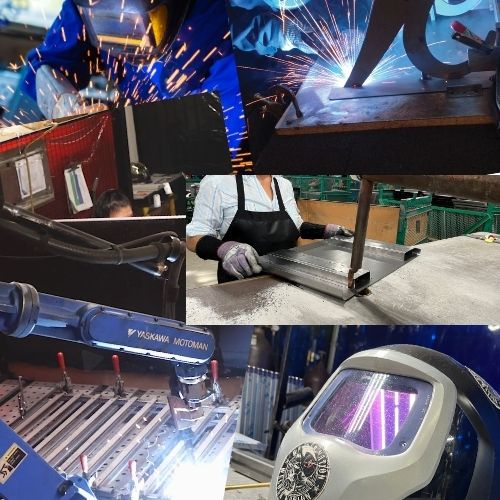
Having different types of welding in a metal fab shop is a give-in. If the metal fabrication shop you currently work with offers welding as a service, is it a metal fab shop? They might be, but welding is one of those "bread and butter" types of the fabrication process. But did you know that not all welding is the same? Different types of welding techniques and equipment are currently available. This two-part series will examine some of the more common weld techniques available at most fab shops, including ours. And then, we will come back to look at more advanced welding techniques in our next feature! Let's look at five different welding techniques you can use.
Stick welding
One of the earliest and most fundamental types of welding is stick welding, sometimes referred to as shielded metal arc welding (SMAW). It entails producing an arc with an electric current between a disposable electrode and the joined metal. The arc's heat melts metal, and a rod made of filler material welds the pieces together. Flux is applied to the rod, protecting the weld from the environment and possibly purging the metal of impurities. Stick welding is an easy and dependable technique. As the flux shields the weld from contamination, you find this type of welding typically in outdoor locations. It is also an excellent option for welding heavier metals because the flux can help improve a weld's penetration.

MIG Welding
Metal inert gas welding is a common type of welding that uses a wire electrode and an inert gas to create the weld. It is a simple form of welding to master and is frequently used to join thin materials. In MIG welding, a continuous wire electrode is injected into the weld pool using a welding gun, and an electric arc melts it. The arc produces an electrical current and travels through the metal and the wire electrode. The substrate uses an inert gas, such as argon or helium, to protect itself from the atmosphere—the gas prevents oxygen and other airborne contaminants from contaminating the weld. MIG welding is a flexible and effective technique. Industries that use this technique include automotive, aerospace, and construction. Moreover, MIG welding is well-suited for thin gauge material and long, continuous welds.
Spot Welding
Joins two or more metal sheets together using resistance welding. It exerts pressure and electrical current on the metal sheets, which heats them and causes them to melt where they come into contact. After cooling and solidifying, the molten metal forms a solid link between the sheets. The spot-welding procedure is quick. You will find spot welds in products such as cars and appliances. It works very well for welding thin metal sheets. The machinery concentrates pressure and heat on a tiny region, reducing the possibility of overheating or harming the metal. Spot welding involves clamping together one or more metal sheets and running an electrical current through them. At the point of contact, heat is generated when the current passes through the metal sheets and forms a resistance. This heat melts the metal, and as it cools, the molten metal solidifies, forging a solid bond between the sheets. The size and shape of the electrodes used to apply the current dictate the size and shape of the weld.
Robotic Welding
Robotic welding is a type of welding performed by a robot. A robot is used in an automated process to weld metal components. Compared to traditional welding processes, robotic welding offers several advantages. It fuses challenging parts for humans to reach and is faster and more accurate. Robotic welding significantly increases production efficiency by operating around the clock. This method eliminates many tedious welding processes. Heavy machinery, aircraft, and automotive industries frequently employ robotic welding.
TIG Welding
TIG welding is short for Tungsten Inert gas (TIG) welding. TIG is a more advanced form of welding that generates the weld using an inert tungsten electrode. You will find this technique when using thin materials requiring high-quality welds. A Tungsten electrode is utilized in TIG welding to generate an arc between the electrode and the metal itself. The arc's heat melts the metal, and the weld pool fills with filler material as necessary. An inert gas, such as argon or helium, protects the arc from the atmosphere. This gas aids in shielding the weld from contaminants. It may require more knowledge to perform TIG welding because it is a more complex process. It is often used for welding thin materials, such as sheet metal or tubing. In addition, welding ferrous and non-ferrous metals like aluminum and stainless steel utilize the TIG method.
Do you have a large project for which you need welding assistance? The experts at Accurate Metal Fab are here to help! We offer various metal fabrication options, including bending, forming, powder coating, and welding. Send us a quote and let us know how we can fabricate together.